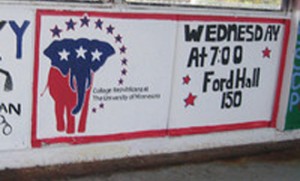Images of “student activism” often bring to mind leftist anti-war protests at Berkeley and Kent State. But across America today, conservative youth are active on many campuses, running newspapers and working through groups of College Republicans or Students for Liberty. Conservatives are active even at institutions with strong liberal reputations – the ones denounced as “indoctrinators” of students by pundits like David Horowitz.
Our research on conservative student activism pinpoints two different styles that tend to predominate in different clusters of institutions. A flamboyantly provocative style flourishes primarily at large state universities and lesser-known liberal arts colleges, while a more traditional “civilized discourse” style of conservative engagement predominates at leading private universities. Each style is encouraged by its own set of national advocacy organizations.
Big Spenders and Provocative Student Activists

Radical activists on the left in the 1960s were often known for colorful language and flashy protest tactics – and the same is true for today’s provocative campus conservatives. They ridicule faculty with labels such as “tree hugging,” “gun taking,” “wealth hating,” and “leftist loving,” and stage showy events like Affirmative Action Bake Sales and Catch an Illegal Alien Days. Reminiscent of Abbie Hoffman and the Yippies, this provocative style of right-wing activism is designed to poke fun at liberals and attract the media spotlight. Where does this style come from, and why is it propagated mostly on large state campuses and lesser known liberal arts colleges?
At the center of today’s conservative youth movement are national organizations with deep pockets and well-articulated templates for confrontational activism. We can think of them as equivalent to Super PACS (political action committees) for college-age conservatism. To plant the seeds of the provocative style, these organizations distribute month-by-month “battle plans” to existing student clubs and send field representatives to help students start new groups. They offer money and extensive networking opportunities to help campus activism grow.
- In 2011, Young America’s Foundation boasted more than $40 million in assets and had expenditures of approximately $15 million, according to audited financial statements. Yearly expenditures underwrote campus speaking tours for conservative luminaries and paid for conservative students to attend regional and national conferences, where attendees would learn how to fight “persecution” with an “activist mentality.”
- With $15 million in the bank, the Leadership Institute spends about $7 million annually to encourage young conservatives. The organization keeps a database of “leftist faculty” and “biased textbooks” on some 2000 campuses, and it has trained tens of thousands of college students to run conservative election campaigns.
These organizations deliver a coordinated message to their young audience: You are under siege on your liberal campuses, and you must use aggressive tactics to counteract the discrimination.
Student Conservatism as “Civilized Discourse”
Despite vast sums of money devoted to its propagation, the provocative style has not taken root on every campus. Right-leaning students who do not fit the “Joe Average” profile (as one leader at Young America’s Foundation dubbed his organization’s beneficiaries) tend to look for support elsewhere. Especially at elite private institutions, students often disparage the provocative style as “not really conservative” in temperament, and as far too populist in its goals and aesthetics. Honing a “civilized discourse” style, these students aim to engage their classmates in reasoned debate, not shock them. They also profess too much respect for eminent faculty to make embarrassing scenes out on the quad. Pragmatically, conservative students at elite universities also want to avoid flamboyant public actions that could pop up in search engines when they apply for prestigious jobs in the future.The best-known national organization nurturing the civilized disposition is the Intercollegiate Studies Institute, founded in 1953 by the late William F. Buckley. The Institute advertises itself as the locale for the “best and the brightest” among conservative students. Financially, the Institute is no match for Young America’s Foundation (the Institute’s 2010 assets totaled $19 million according to the liberal research group MediaMatters). Yet it appeals to right-leaning students with more highbrow interests by offering seminars and internships plus networking opportunities for students interested in writing for the National Review or the Weekly Standard. Although some conservative students regard the Institute as a stuffy old boys’ club, those who do get involved see themselves as well prepared to pursue refined political discussions.
Causes and Consequences
Although students self-select into different types of schools, and schools likewise select specific types of students, there is strong evidence that young people imbibe their campus’s dominant mode of conservatism after they arrive at college. The provocative and civilized styles are encouraged by distinct sorts of national sponsors, and each is fostered by the climate and practices of the kinds of campuses where it predominates.
Obviously, these conservative styles fostered on Americas’ college campuses mimic the divide between populist and mainstream conservatism in today’s Republican Party – though in recent years populism has so penetrated the entire party base that provocative efforts must now be attempted by virtually all GOP candidates. Our research on conservative student activism suggests that distinct goals and styles will likely persist, as rising Republican leaders come out of college. There is also a real chance of growing schism. Unless conservatives who enact the disparate styles can reclaim common ground, the Republican Party may be in danger of splintering still further in future years. Contrasts in leadership goals and styles are not just prevalent in older generations. These differences are steadily replenished, even exacerbated, as future conservative leaders emerge from today’s campus training grounds for activism.

 Research to Improve Policy: The Scholars Strategy Network seeks to improve public policy and strengthen democracy by organizing scholars working in America's colleges and universities. SSN's founding director is Theda Skocpol, Victor S. Thomas Professor of Government and Sociology at Harvard University.
Research to Improve Policy: The Scholars Strategy Network seeks to improve public policy and strengthen democracy by organizing scholars working in America's colleges and universities. SSN's founding director is Theda Skocpol, Victor S. Thomas Professor of Government and Sociology at Harvard University.